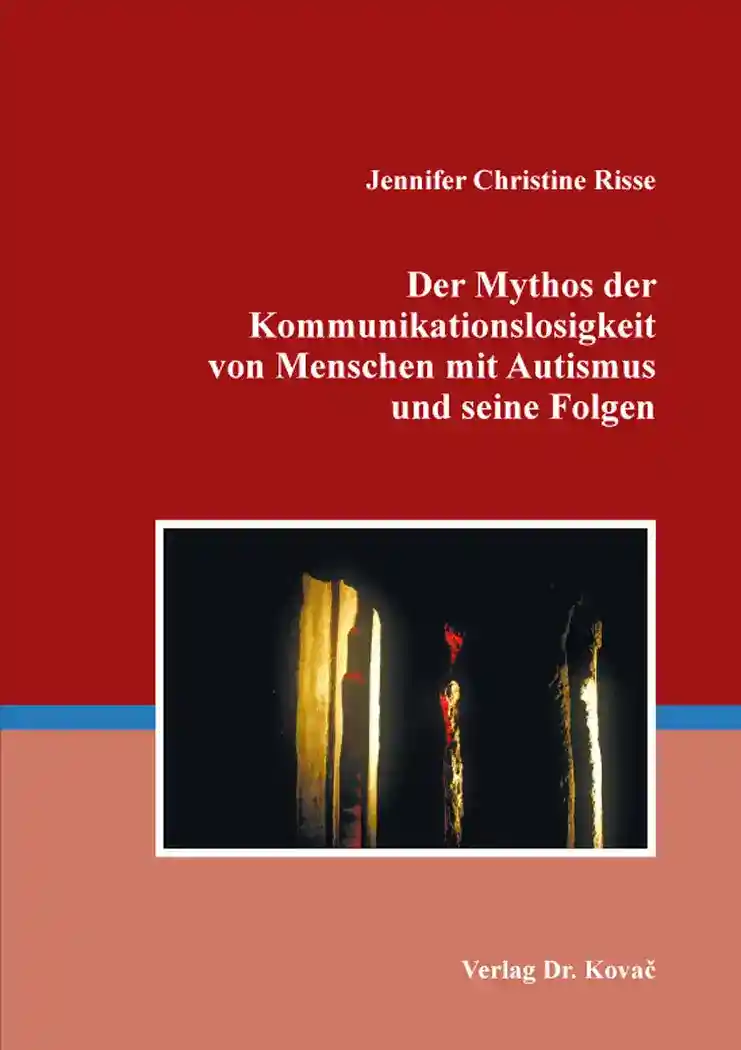Jennifer Christine RisseDer Mythos der Kommunikationslosigkeit von Menschen mit Autismus und seine Folgen
Soziologische Theorien in der Diskussion, volume 8
Hamburg 2018, 166 pages
ISBN 978-3-339-10166-2 (print) |ISBN 978-3-339-10167-9 (eBook)
About this book deutschenglish
This is a thesis on "The myth of the lack of communication of people with autism and their consequences". The work emerged from the idea that autism is not the reason for lack of communication, but rather the circumstance which reactions in the way of communication, the knowledge of the persons involved in the interaction, are advancing. This refers to how people who are neurotypical react to those people who react a typical for you, in this case the Autist as a conversation or interaction partner. In the first part, the thesis deals with the "disorder" of autism as such, which symptomatology is attributed to, which forms exist, which current theses outline how it arises and what autism means. Likewise, the diagnosis and therapy will be discussed. Also, this chapter provides a brief insight into the point of view of those affected, as illustrated by examples from a short survey of autistic individuals. It also refers to the books of Bernhard Schmidt and the Empowerment thought of Prof. Theunissen.
The second part deals with the field of general communication, first with a definition of communication, to delve deeper into the origin and psychology of communication, which, of course, is not fully dealt with, as it would have disrupted the scope of the work. Two selected communication models are presented, the Grice conversational maxim and the Rogers communication principles. Paul Watzlawick was deliberately omitted here, as this is the only part of the next chapter. Furthermore, the areas: human images, rhetoric and communication are treated as the key to social life, before it goes into the communication model of Paul Watzlawick. In order to get into his theories, the person Paul Watzlawick and his life and work are briefly introduced first, followed by the basics, axioms, paradoxes, constructivism and disturbed communication, so all areas of Watzlawick's therapy , Here are the individual axioms: "One can not not communicate; Each communication has a content and a relationship aspect; Communication is always cause and effect; Human communication makes use of analog and digital modalities; Communication is explained symmetrically or complementarily.
The next chapter is the interview with Dr. Ing. Schmidt, who is autistic himself and writes, books from this subject area. One of these books is entitled "A Cactus for Valentine's Day - An Autist and Love". In his books, he describes in great detail how he experiences his reality and how he deals with all these difficulties in communication. For this reason, he was chosen as an interview partner and asked about all the topics of the thesis according to his views. For this purpose, all individual chapters of the work are referred to and questions are asked.
This should lead to the last chapter, in which the connection is made to social work and how relevant this topic is in working with people in such contexts. Here, the points of contact between social work and the other fields: autism, communication and the theories of Watzlawick are shown. In each case, each of these areas will be examined in detail and how individual weighting also has to be in the practice of social work. This leads into possibilities of the application, whereby the practicability, problems, as well as solution strategies are presented on this topic. At the end, as conclusion, a final conclusion is added, which describes the own view of the author of the thesis, which experiences were collected during the work for this thesis, but also a conclusion of representatives of the science and social work, as well as of course the voice of those, which it really concerns the most: the autistic. This is more a kind of opposition.
The idea for the topic of this work emerged in different sections of the study of social work of the author. The first impulse was shortly after a change of university in the third semester, here was part of the study a visit to a course on developmental psychology. This course provided the first impetus and aroused interest in the theories of Paul Watzlawick, especially here in the context of adulthood. In the beginning, however, the spelling of Mr. Watzlawick presented as a challenge, but steadily grew the number of books on this subject and crystallized as part of the issue out.
The second part of the issue shows of in the practical semester, the work with young people in the context of vocational training in rehabilitation. In the course of this practical semester has had to be taken care of; from the initial interview to the admission to the workplace, the first school visit and the co-creation of the first event. Here is a situation of a case that should be remembered: The young man is described as a very aggressive and inaccessible autistic youth. The report about him was riddled with innumerable negative experiences. It was agreed that they did not read this completely (only from the practice instructor). The first meeting was very positive. The young man was friendly, polite, open and very communicative. It was noticeable when he was made to take him seriously and try to understand his point of view that he could be quite different than described by the competent jobcenter. The misjudgment was a pure problem of communication, as it turned out in the course of the conversation.
This was the crucial point to this area of the thesis. It aims to show that the problem with communicating with autistic people is not a problem for the autistic, but interplay between norms bounded by society in the field of verbal, nonverbal and paraverbal communication and in some respects the indomitable ignorance of autistic communication, which is mostly rather like myths than the concept of truth and logic.
For readability, all the work is written in generic masculine. Likewise, in various quotations, the spelling mistakes have been corrected for easier understanding.
Kontaktmöglichkeit
Keywords
AutismusAutismus-Spektrum-StörungKommunikationKommunikationslosigkeitKommunikationsmodelleParadoxienPaul WatzlawickPeter SchmidtPsychologieSchulz von ThunSoziale ArbeitSozialpädagogikIhr Werk im Verlag Dr. Kovač

Möchten Sie Ihre wissenschaftliche Arbeit publizieren? Erfahren Sie mehr über unsere günstigen Konditionen und unseren Service für Autorinnen und Autoren.
